The first week of spoilers has ended and brought us 47 new cards to look at and be excited about. While everybody else is away trying to rate, analyze them and predict how good they are going to be according to one set of criteria or another, we will take a look at the most interesting and standout cards that we have seen so far.
Criteria
What constitutes as interesting will vary depending on who you ask, so I want to clarify what I consider to be interesting and how the cards have been picked from the total of fifty revealed ones at the time of writing:
- New mechanics – obviously, any time there is a new interaction introduced to the game it’s hard not to get excited about all the possibilities, but some things will be more interesting than others. Whether it’s the promise of infinite value, crazy card combinations or obscure mechanics that nobody is really quite sure how they work, the idea of doing something new that was previously not possible or widely available outside of corner cases is exciting. This will be the primary criterion for card selection and participates in one form or another into the other smaller criteria used to make this list.
- Quirkiness – a card doesn’t always have to be particularly powerful or the greatest thing ever to be interesting. Sometimes there are really odd effects that catch the eye, provoke questions in the player and warm the hearts of deck builders who make it their life’s work to win with weird and underpowered cards.
- Experience – often times in new sets we see various renditions of mechanics from the past, mostly in the form of “fixed” versions of very powerful effects. It’s difficult not to be interested in cards like those. Even if they don’t turn out to be very powerful, as the game matures and we have more experience with “what’s good” and how strong certain effects are, we have to always be wary of the danger and look at them critically.
- Managed expectations – this is one of the most important criteria when it comes to looking at new cards and as we explore our selection further below we will see this in full force. If a card is crazy good for a certain archetype or in a specific situation, we can’t wave it off as a bad card. Not every single card has to be great against aggro while also being amazing against midrange and good against control, making you not die and winning you the game at the same time. In fact, that’s downright impossible. We have to look at cards the way they are meant to be used and not dismiss them because they aren’t good when they aren’t supposed to be.
- Respecting formats – while Standard is the more competitively and more widely played of Hearthstone’s two constructed formats, we should not forget that the other one exists. There are decks and archetypes that no longer exist in the former which continue to live a long and rather prosperous life in the latter and sometimes new cards will be a lot more impactful there than in Standard. We will be looking at cards that are interesting, regardless of their applications in Standard, Wild or Arena.
- Predicting the meta – naturally, it’s very hard to accurately tell what a future metagame will look like, especially with less than half of a full set revealed. Naming decks as good or bad is a downright impossible task without full information, but there are a few things that we can try to predict – namely, the speed of the metagame. We have to make a lot of assumptions when evaluating new cards and the biggest assumption I’m going to make here is that the KFT meta will be slower. I won’t go as far as calling it a “control meta” (Reddit’s biggest passion), however I do think it will be noticeably slower than the current one. The newest set heavily features the Lifesteal keyword and almost all cards we have seen so far are not on the fast side of things. The inclusion of the Death Knight hero cards should help as well – if the devs want any of them to see play, the have to have slowed down the pace of the game in order to support them.
We are starting things off with a card that introduces a new spin on an a couple of old mechanics. Warlocks are not unfamiliar with getting benefits from their effects when they successfully kill a minion, with the primary example being Mortal Coil. What’s really interesting about Defile is how it’s cast again – does it count the player as casting the card over and over and thus increasing the Yogg count several times? Does the game think Defile is casting itself again and again, or is the game itself creating new copies of the card to be cast on the board? I’d wager it’s the first option, but we don’t have a definitive answer to that question just yet. We have to remember that non-players can be the casters as spells too – Yogg doesn’t increase the spell count because the player is not the caster.
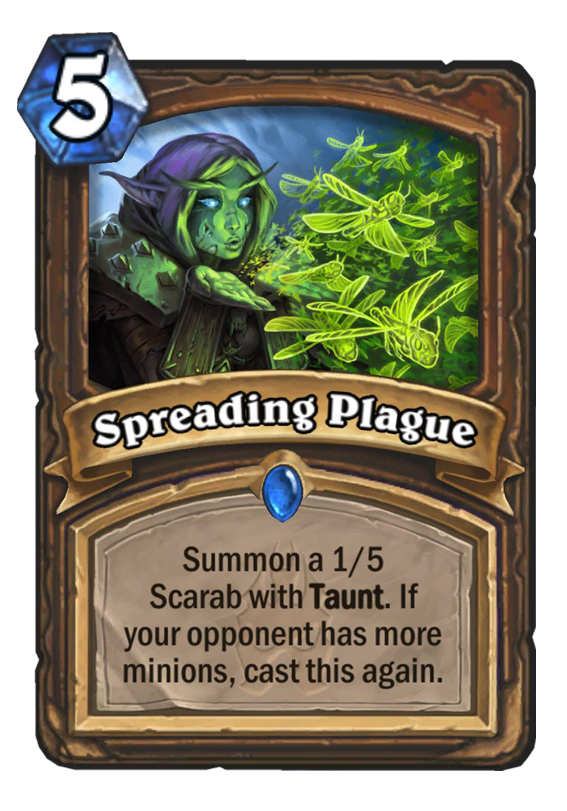
There was also another card revealed with Defile that shares the “cast again” mechanic, Spreading Plague. The reason that Defile reminds me of a couple old mechanics is much more clearly expressed here. Remember Unleash the Hounds? It could just as easily read “Summon a 1/1 Hound with Charge. If your opponent has more minions, cast this again”, much like Plague does. Now, I don’t know if Unleash is going to be reworded with the new text and if I had to bet I’d say it won’t because that would also be a functional change in the corner cases where you have minions beforehand or when the opponent has none, but otherwise they do function very similarly, except of course Plague and Defile trigger on-spellcast effects multiple times. While it’s a “bad combo”, you can cast Defile with a Violet Teacher in play to deal 5 AoE damage without setting up the domino effect beforehand.
Overall, it’s quite the interesting refurbish on these old mechanics and I suspect there will be more spells with this mechanic that we are yet to see, possibly even one for each class.
Talking about fresh spins on old mechanics, how about combining secrets and deathrattles into… well, secret deathrattles! Regardless of how good Fatespinner is with each deathrattle individually, I think everyone can agree that nobody expected this to be a thing. The biggest reason this card makes it onto the list, as we’ll see with some of our next choices, is that it puts this weird new thing on the table at all. Fatespinner can be the worst card in the set (though I would argue it’s actually good) and we should still be all over it – Blizzard likes to test new mechanics in advance on some weird and funky cards and this seems just about to be the case here. We have no idea if it’s a Druid-only thing, turning them into a fourth secret-esque class, or if we’re going to see this featured more prominently in the future, but like many of the Knights of the Frozen Throne cards, the fact that this exists opens the floodgates.
In previous eras the devs would have shied away from mechanics such as these that introduce more complexity to already existing mechanics, but I’m very glad they have not withheld on this set. If we think about it more, this is Druid’s good ol’ “Choose One” mechanic, except the outcome is unknown to the opponent. Like previously stated, we could see more secret deathrattles in the future, but another plausible spin on this would be secret “Choices” from Druid’s original class identity mechanic. This expands it further from being a class-specific version of Battlecry with options and for that, Fatespinner makes it onto this list.
This card is particularly interesting because almost nobody anticipated to see an effect like this one in Hearthstone for quite some time. True milling, MTG style, is considered by many to be “unfun” and without significant counterplay. As such, in the past designers said there won’t be any such effects in Hearthstone and in fact Priest’s own Thoughtsteal was changed during Alpha from “stealing” two cards from the opponent’s deck to copying them. Yet here we are, with Gnomeferatu. Naturally, this card can range from terrible to great depending on the circumstance. Against aggro and aggressive midrange decks where most cards are interchangeable threats, this card doesn’t do too much. However against control or particularly against combo, this can hit an important piece of the deck like a win condition.
It’s a very “feast or famine” design that I’m not particularly fond of, but I sure am excited about having an interaction like this in the game. Much like Fatespinner, it opens the floodgates of what’s possible or allowed in the game and as a control player at heart, I’m looking forward to more of these kinds of mechanics. But it is unfun, and we have to avoid this as much as possible. Gnomeferatu is entirely reliant on a blind RNG throw where hitting or missing depends purely on chance. There is (with the current card pool) no skill involved in “feeling out” a good time to play it, like Dirty Rat or a specific point the game where it shines. In fact, it’s a lot better as early as possible, so that the opponent can’t have yet drawn the good cards you want to hit with it. I imagine controlling Warlock decks are going to play two of these just on the off chance that they hit something important, because such a deck is more than happy to play a 2 mana 2/3 for some resemblance of board presence.
A particularly cool interaction in Wild that you can do with this in Renolock is to play Brann Bronzebeard, Kazakus, Dirty Rat and Gnomeferatu on the same turn – you have to Brann out the Kazakus because that’s the strongest thing the deck does, but you can also use your Brann turn to remove two cards from the opponent’s deck and prevent two battlecries from activating. It’s actually fairly good, but even if it weren’t, currently that’s the biggest slap in the face you can give your opponent.
If you don’t think manipulating mana is dangerously powerful, you have not been playing card games enough. Especially in a game with a constant stream of mana, cheating the curve by discounting cards or making them cost more is one of the strongest effects you can get. Some people have referred to this as “the new Loatheb“, while others have said it’s a lot worse than Loatheb. They are similar in the way they function, but personally I don’t think they have the same applications. While this effect is symmetrical, it is permanent for as long as Nerubian Unraveler is alive and with proper deck building, one could take advantage of that fact. This card is obviously not for every archetype and every deck, but an aggressive midrange deck can top their curve with this and lock down AoE for 2 additional turns or until Unraveler has been dealt with, both of which are roughly equivalent to winning the game. Five damage is not the easiest to come by and most things that deal so much damage also cost amounts of mana similar to Unraveler himself when under its effect, so in the worst-case scenario it still trades 1 for 1, sometimes even more. In this scenario, where you would ideally use Unraveler, it does resemble Loatheb a lot and in Wild you would probably still play him over Nerubian Unraveler, however in Standard this effect will be very powerful, especially in a slower meta where midrange decks can reign.
What’s particularly good about this card is that it has other applications other than stopping a control deck’s AoE from coming down. If you are ever losing to very spell-heavy decks like Freeze Mage, Quest Mage or Miracle Rogue, you can always include this card to make them a little bit more fair. A 5/5 minion is just big enough to provide pressure and the 6 mana investment, while not small, is not that much at all. People love to quote how a 5/5 is worth about 4 mana and you will be “overpaying” by 2, but the fact of the matter is that if you don’t have a 4 mana 5/5 and something to do with the rest of your 6 mana on turn 10, then it really makes no difference. Spell-heavy decks are usually slow to start going off, so you will have plenty of time to find and play your Unraveler.
We have to take into account the symmetry of the effect, of course. If we are playing the aggressively built midrange deck we are happy to run this, given that what few spells we do have, we will be able to cast comes turn seven. Even in aggro decks, playing this to make answers from the opponent more costly is not the worst idea in the world, as even the aggro playstyle usually stops caring about the board come the later turns and attempts to burn out the opponent. That’s when Unraveler can backfire, although it will be a lot more prohibitive for the controlling decks than the rest. If ever the meta is just right for those midrange decks to be strong, this is the card that will drive the over the top and into the oppressive category.
Do you like “infinite value”? Because I do. This term gets thrown around a lot, however now we have before us a real example of an infinite value card and that’s Dead Man's Hand. For those who are unaware of the combo, the idea is that with two copies of Dead Man's Hand you can “go infinite” by playing one of them and shuffling your hand into your deck, then waiting until you draw the one in your hand shuffled this way in order to have two of them again, then playing whatever it is you had in your hand. Too convoluted? Let’s give take a look at the example where you have a N'Zoth, The Corruptor and two Dead Man's Hands:
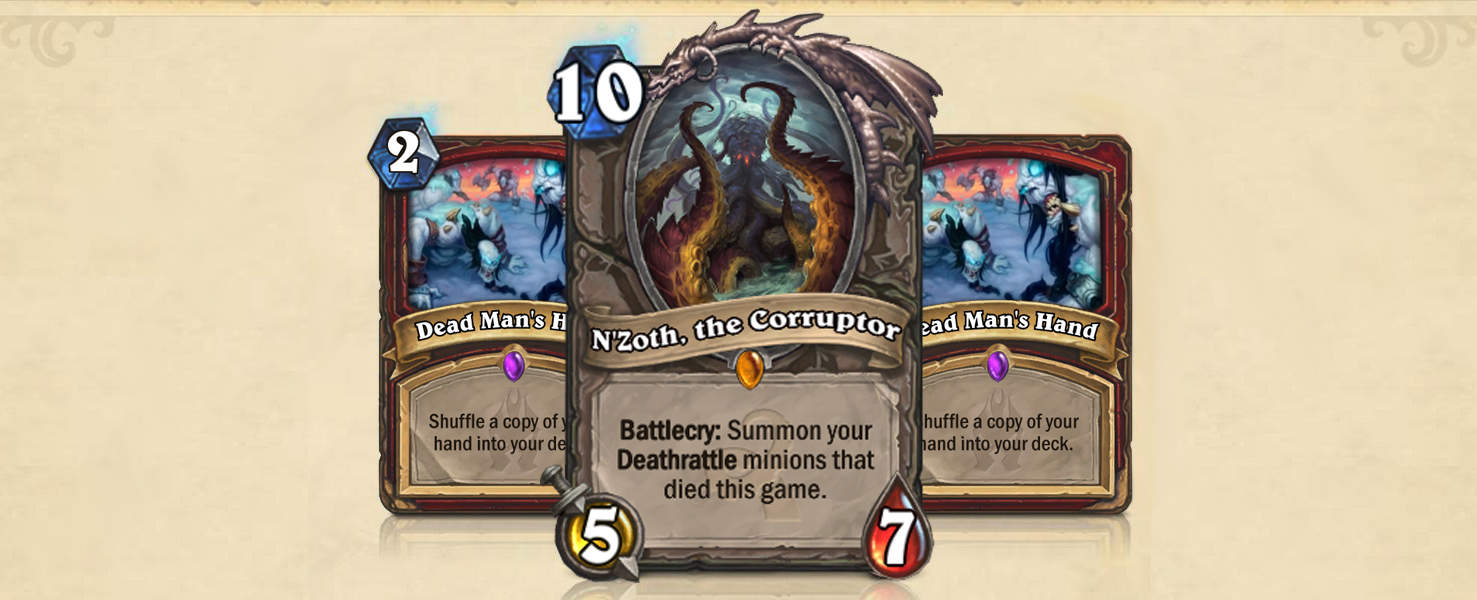
In order to feel like a Jade Druid and generate infinite N’Zoths, all you have to do is this (assuming no cards left in the deck for better demonstration):
- Step 1 – Play Dead Man's Hand, shuffling Dead Man's Hand and N’Zoth into your deck.
- Step 2 – Draw a card. You now have a Dead Man's Hand, a N’Zoth and one of the two shuffled cards. Play the original N’Zoth you had.
- Step 3 – Draw a card. You have returned to the state in which you were before Step 1. Rinse and repeat.
Why would you want to do this? Generally, because playing N’Zoth is the most powerful thing you can currently do in Hearthstone, especially in Wild. Unlike Jade Idol, N’Zoth actually summons a full board of value, providing both defense and pressure at the same time. Dead Man's Hand makes sure that you can outlast board wipes, trades, etc.
Of course, there are many cons to such a strategy. Is it too slow? Isn’t it bad to have to wait until you draw your entire deck to do this? Yes, it is incredibly slow, but that’s not necessarily a bad thing. Pretty much every deck that plays N’Zoth is slow compared to most other archetypes, yet they are still very powerful. Like I mentioned in the beginning, not every card has to be good against aggro to see play. Dead Man's Hand is possibly one of the slowest cards to ever see the light of day when used in that particular fashion, however that doesn’t mean it’s not ridiculous when played appropriately. Just by making this possible, Hand deserves serious consideration. The best part about using it as a win condition is that it requires relatively low deck space – since it will outvalue and outlast other control decks, all your deck needs to do is not die until that point. Warrior has been traditionally very good at that and this can bring back the good old Control Warrior back to relevance once more.
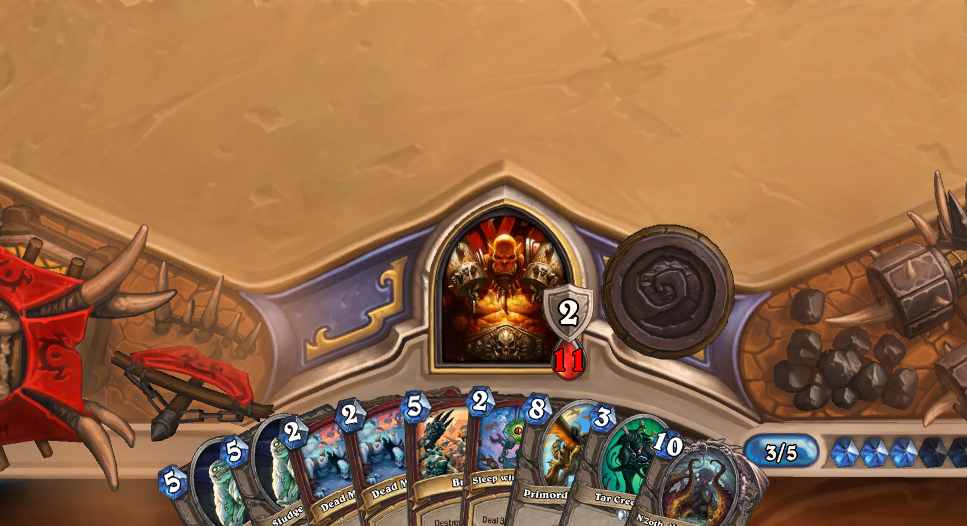
With that being said, there are plenty of other ways to play with Dead Man's Hand. You don’t have to go infinite, it’s still a fantastic value generator on its own right, as well as a downright win condition when paired with other specific cards. It’s slow either way, so it will only see play if and when a Control Warrior takes shape as a relevant part of the meta, but it will be one of the most powerful cards in that deck.
Talking about value, here it is – and its name is Archbishop Benedictus. I am honestly surprised this card will be getting released because that’s one of the most powerful effects I have ever seen. This card generates so much value. Your opponent’s deck, or what’s left of it when the Bishop comes into play, is made up of cards they wanted to put. It will more than likely contain powerful effects that often times generate even more value on their own, let alone the crazy powerful interactions that can happen once cards hop on over to another class. If we are ever in a true control meta, this card can see a lot of play.
It has its problems, of course. Despite how crazy strong the effect is, it’s not actually very good. Historically, we have never had a true control meta and shuffling aggro decks into your own is a terrible idea. Most often than not, actually playing Benedictus will result in a big inconsistent mess of a deck and prevent you from drawing the cards you put there intentionally, not to mention he is a 4/6 on turn 7 with no other ability, so playing him will be a lot like passing the turn back to the opponent. His effect is crazy good but it comes at a cost and not every deck can pay it.
Watch out for this card in control mirrors, especially in Wild – Brann Bronzebeard into the conveniently costed Archbishop Benedictus is going to give your Reno Mage or Renolock a run for their money!
Those were the most interesting picks from the first week of card reveals that caught our eye. It will be really a really exciting to go into the second week of spoilers, especially since Matt Place called it “Death Knight Week” and we can’t wait to see a new Death Knight hero card every day! Stay tuned for more interesting and exciting cards next weeks and follow @HSTopDecks for the latest updates, latest spoilers and all the Knights of the Frozen Throne action!

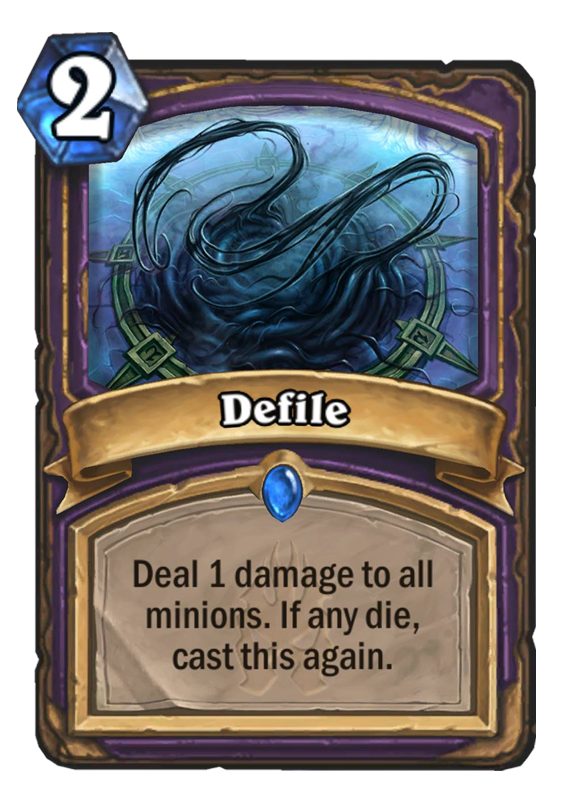
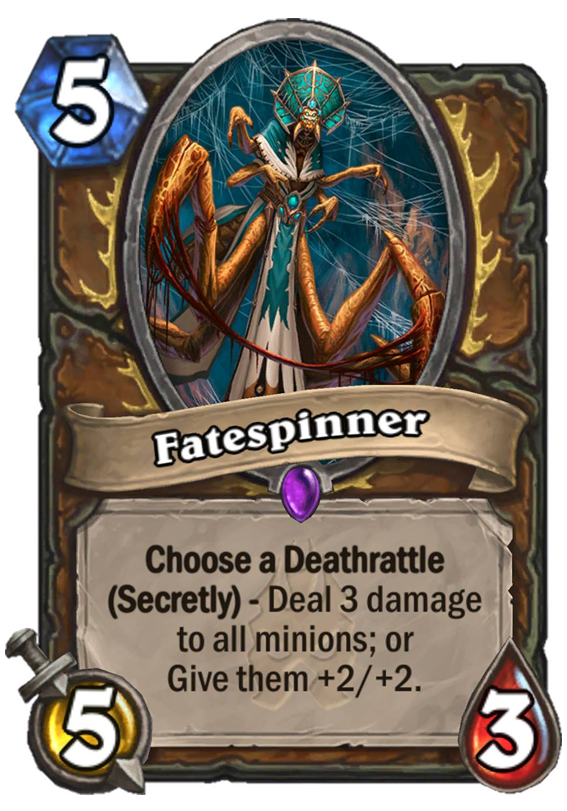
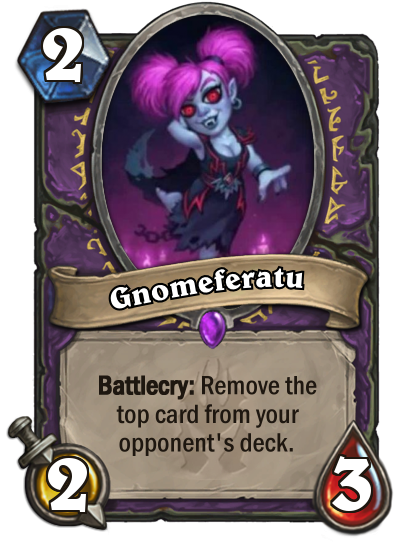
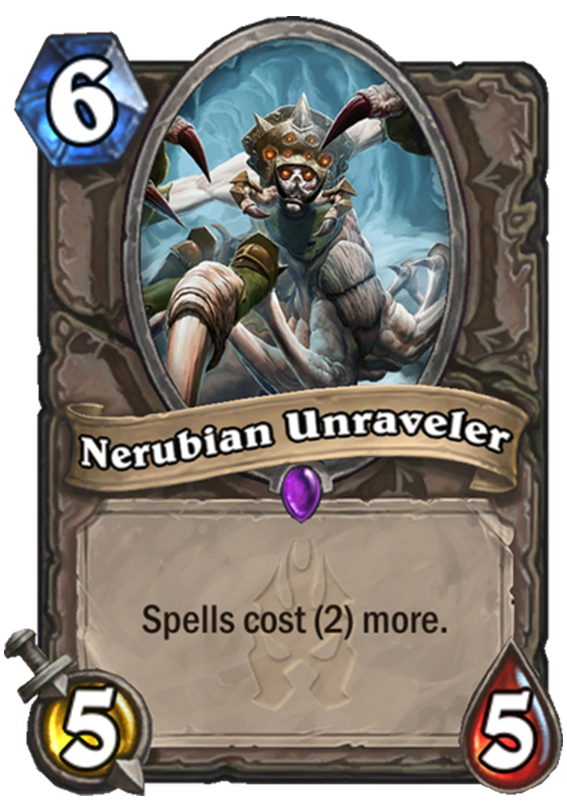



Unleash the hounds would not be reworded because it works a bit different than spreading plague. You can have more minions with UTH than your opponent and spreading plague only balances both player’s minion count. For example,if you have 2 minions and your opponent have 3,casting UTH will give you 3hounds. Giving you a total of 5 minions. But casting spreading plague would only give you one.
Cool article! I have enjoyed seeing these new mechanics and I am excited to try them out.
The reason the Spreading Plague card is worded like this is because Blizzard didn’t want it to do nothing if your opponent has no minions. Currently, Unleash the Hounds doesn’t summon ANY minions if your opponent has no minions, whereas Spreading Plague will always give you one scarab even if your opponent does not have minions.
Both of you are correct of course, in fact I mentioned that I very much doubt it will be changed. Perhaps I failed to clarify that rewording Unleash won’t keep it as-is and will slightly change how the card functions, but seeing something like Spreading Plague really makes me reminisce of Unleash.
I will make sure to edit the original text to avoid confusion, thank you for pointing it out!